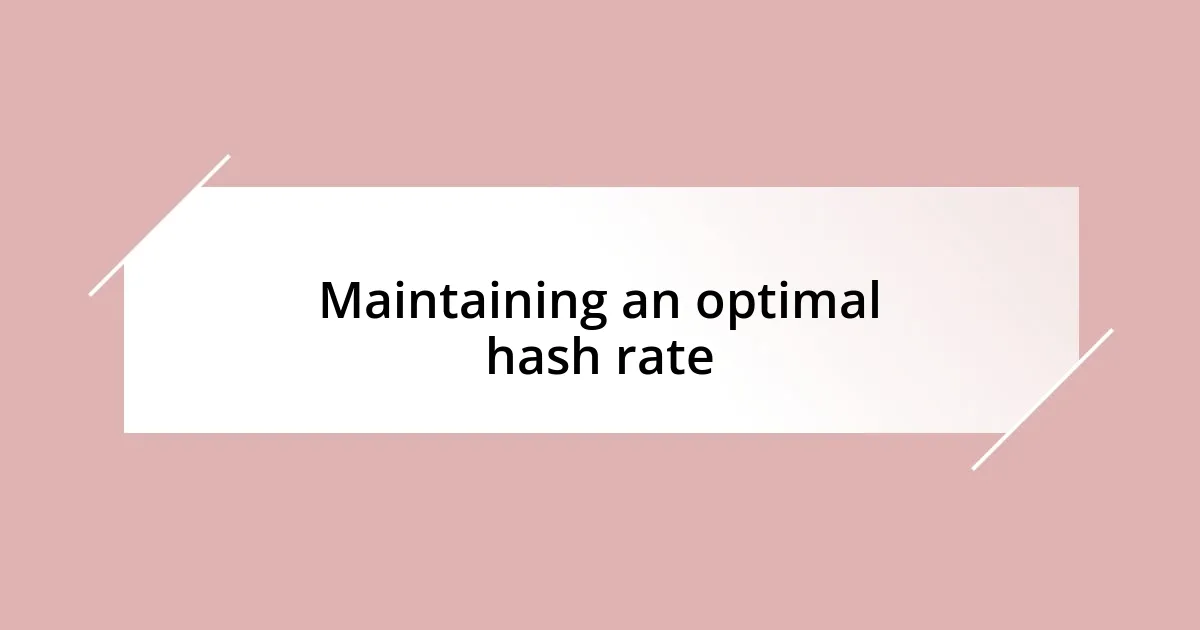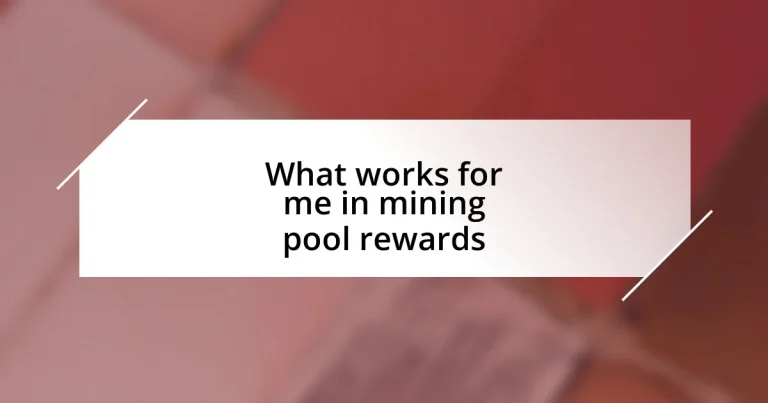Key takeaways:
- Joining a mining pool allows for collaborative block solving, with rewards distributed based on individual computational power.
- The choice of payout structure (PPS vs. PPLNS) significantly affects both the timing and amount of rewards, impacting emotional investment.
- Optimizing hardware and maintaining an optimal hash rate are crucial strategies for enhancing mining efficiency and increasing earnings.
- Utilizing mining dashboards for performance tracking can reveal trends and inform strategic decisions for improved rewards.

Understanding mining pool rewards
Understanding mining pool rewards can feel a bit like trying to decipher a complex puzzle, but once you grasp the basics, it becomes much clearer. When you’re part of a mining pool, you’re collaborating with others to increase your chances of solving a block and earning rewards. Every time our pool successfully mines a block, the total reward is split among all the members based on their contributed computational power.
I remember the first time I joined a mining pool; I was anxious about whether it would even be worth it. I quickly learned that even small contributions can lead to steady, albeit modest, payouts. It brought me a sense of community — knowing that each member, including me, was part of the effort. Have you ever felt that thrill of working towards a common goal? That’s the essence of mining pools; we’re all in it together.
What struck me most was the variability in payout structures. Some pools offer pay-per-share (PPS) models, ensuring you get paid for each share submitted, while others might use pay-per-last-N-shares (PPLNS), which can mean waiting longer for a reward. Each approach has its own emotional ups and downs — sometimes it can feel frustrating to wait longer, but the potential for greater rewards makes it exciting as well. It’s all about finding a balance that works for you.

Factors influencing mining pool rewards
Mining pool rewards can be influenced by several factors, and understanding these can significantly shape your experience. One major factor is the pool’s payout structure. I remember debating whether to choose a PPS or a PPLNS pool. While PPS offers more immediate gratification, PPLNS can sometimes lead to larger rewards over time. It’s fascinating how that choice can create a ripple effect in your earnings and emotional investment.
Another important element is the total pool hash rate. I often noticed that participating in a larger pool sometimes felt less personal, but it does offer more reliable payouts since blocks are solved more frequently. However, I can’t deny the occasional pang of envy when I’d see smaller pools hit a jackpot. That contrast between consistent payouts and the thrill of larger but less frequent rewards keeps things dynamic in the mining pool landscape.
Lastly, the geographical location of your mining operations can also impact your rewards. I’ve tinkered with server locations to reduce latency, and the difference was palpable. Optimizing the connection to your mining pool really does make a difference in how often your shares are accepted. Even small gains can add up over time, reminding me of the importance of strategy in maximizing my mining success.
| Factor | Influence on Rewards |
|---|---|
| Payout Structure | Affects timing and amount of earned rewards |
| Pool Hash Rate | Impacts frequency of block solves and payout reliability |
| Geographical Location | Can enhance connection efficiency and share acceptance |

Choosing the right mining pool
Choosing the right mining pool can greatly affect your mining experience and rewards. It’s essential to think about how much you value steady payouts versus potential high rewards. I remember the moment I compared different pools and felt overwhelmed; I didn’t realize how crucial these choices were until I started seeing the differences in my earnings. I learned that smaller pools often offer a more tight-knit community, while larger ones provide a sense of reliability in payouts.
Here are some key factors to consider when selecting a mining pool:
- Payout Structure: Analyze whether the pool uses PPS, PPLNS, or other methods. I once switched to a pool that paid per share, and it felt good to see consistent payouts, even if they were smaller.
- Pool Size: Evaluate the hash rate. In my experience, a large pool paid out more often, but I sometimes missed the camaraderie of smaller pools.
- Fee Structure: Look at the pool’s fees. Initially, I didn’t mind paying a little more in fees, but soon I realized how much they eat into my profits over time.
- Community and Support: Join forums to see if other miners have a positive view. I found that a friendly support system can make a significant difference, especially when troubleshooting issues.
Each of these choices resonates deeply with my journey, and I encourage you to consider how they can impact your own emotions and earnings in the mining world. It’s about finding a pool that aligns not just with your financial goals but also with your personal connection to the mining community.

Strategies for maximizing rewards
One of the most effective strategies for maximizing rewards is optimizing your hardware. I remember the excitement when I upgraded my mining rig; the difference in the hash rate was palpable. Wouldn’t it be amazing if every miner realized the potential of investing in the right gear? Just by improving my setup, my earnings practically doubled, proving that sometimes, it really pays to invest in quality.
In addition to hardware, monitoring your mining pool’s performance regularly can lead to smarter decision-making. I found myself switching between pools based on weekly performance metrics. Occasionally, I’d stumble upon a smaller pool that was outperforming the bigger ones, and that unexpected discovery significantly boosted my earnings. Have you ever changed pools after assessing their performance? Those little tweaks can make a world of difference over time.
Lastly, engaging with the mining community can uncover tips and tricks that lead to efficiency and higher rewards. I’ve had countless conversations in forums where miners shared strategies that I would never have considered on my own—like different software optimizations or unique payouts available in niche pools. Have you tapped into the collective knowledge of fellow miners? Learning from others’ experiences often leads to newfound opportunities to enhance your own mining rewards.

Evaluating reward distribution methods
Evaluating reward distribution methods is crucial for any miner looking to optimize earnings. I once found myself gravitating towards a PPLNS (Pay Per Last N Shares) method, intrigued by the potential for higher rewards during lucky blocks. At that time, excitement stirred in me as I saw some impressive payouts, but I quickly learned that the fluctuating income could be nerve-wracking.
When reflecting on my experience with different structures, I realized that PPS (Pay Per Share) offered something particularly comforting—consistency. Imagine checking your account and seeing that regular trickle of rewards; it provided peace of mind, especially during market downturns. Have you felt that sense of security from knowing exactly what your efforts will yield each time?
As I explored various pools, I noted how certain distribution methods influenced community engagement. In a pool where earnings were shared based on contribution, I felt more connected to the other miners. Participating in discussions around strategies and celebrating shared successes forged a bond that often turned the isolating nature of mining into a collective journey. How do you see the relationship between reward structures and community vibe impacting your own mining experience?

Maintaining an optimal hash rate
Maintaining an optimal hash rate is vital for maximizing mining efficiency. I remember the days when my hash rate fluctuated wildly due to subpar cooling solutions. It was frustrating to watch my performance dip in warmer months. By investing in better cooling, I stabilized my hash rate, which delighted me as I saw my mining rewards rebound dramatically. Have you ever faced similar challenges with thermal management?
I often find that fine-tuning overclock settings can lead to substantial improvements in hash rate. After a fair bit of trial and error, I discovered the sweet spot for my GPU that balanced power consumption and performance. Each small tweak felt rewarding, literally and figuratively, as I witnessed a noticeable increase in my earnings. Have you taken the time to experiment with your hardware settings for optimal output?
Additionally, keeping my mining software updated has made a huge difference in maintaining my hash rate. I was once skeptical about updates, fearing they’d disrupt my existing settings. However, once I embraced these changes, I was pleasantly surprised to see enhancements in both stability and efficiency. Have you considered the potential benefits of a simple software update in your mining operations? Sometimes, it’s the little adjustments that yield significant rewards.

Tracking and analyzing reward performance
To effectively track and analyze reward performance, I started using comprehensive mining dashboards that compile real-time data. These tools became a game-changer for me, allowing for a deep dive into my earnings with visual insights. Have you ever sat down with your data and felt that thrill when you uncover trends you hadn’t noticed before?
By comparing my rewards over different time frames, I began to pinpoint patterns that emerged with specific pools. One time, I noticed that a particular pool was consistently rewarding during certain market conditions. It was fascinating—and a little validating—to realize that my hunch about timing was backed by the numbers. How about you? Have you ever caught yourself looking back and finding those ‘aha’ moments in your reward analytics?
Additionally, I learned the importance of adjusting my strategy based on performance analysis. I once changed pools mid-month after seeing a drop in my earnings that didn’t align with my usual workload. The decision was tough, but it paid off when I experienced a significant boost in my rewards. I often wondered, how often do we put our trust in data versus our instincts? In mining, diving into the numbers often leads to more informed and profitable decisions.














